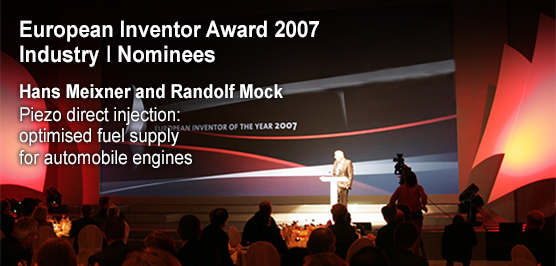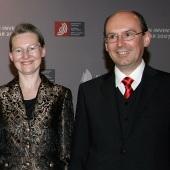Hans Meixner, Randolf Mock
Piezo direct injection: optimised fuel supply for automobile engines
German inventors drive diesel engines to greater efficiency
Hans Meixner started his research in the 1980s but it wouldn't be until the mid-1990s - when fuel efficiency was suddenly making newspaper headlines - that the world was ready for the innovation he and his colleague Randolf Mock came up with.
Working at electronics giant Siemens, which already had a long-running involvement with piezo materials (crystals, ceramics and polymers), the time seemed ripe to apply this technology to diesel engines to make them more environmentally friendly.
The idea for adapting piezo technology was based on the understanding that a piezo switch is able to respond almost instantly (within one ten-thousandth of a second) to an electrical charge. This means fuel flow can be more precisely calibrated, and it burns more completely. The result: better fuel economy and lower emissions.
The piezo switch is made of a ceramic material which expands when an electrical current is applied. Similar technology is used in computer inkjet printers which emit tiny drops of ink when their piezo crystals are charged. The difference here is that with fuel injection, the piezo technology opens a valve allowing fuel to be sprayed into the engine cylinder.
Tests back in the 1980s with early injection prototypes were promising, and the duo realised they could achieve fuel savings of approximately ten percent using this method. Fast forward to 1996 and their first test injector is in existence. From that point, it would only take four years for Siemens VDO to become the first European supplier to start series production of injection systems for diesel engines.
With the launch of the Peugeot 306 diesel - which was noted at the time for matching up well to its petrol-based competitors in fuel efficiency and handling - the scientists finally saw the fruits of their labour on the market.
Today, piezo technology is installed in virtually every modern diesel car on the road with drivers enjoying fuel savings of up to 15 percent. By the end of 2006, Siemens had supplied 18 million diesel injectors to customers across the globe, translating to nearly five million cars that now use the technology.
But it's not just diesel customers who are going to benefit: according to Siemens, there are even greater savings (as high as 20 percent) to be had when using this technology with petrol engines. BMW obviously agree, unveiling in 2006 their 335i Twin Turbo 3-litre engine that uses Siemens VDO's piezo direct injection gasoline (petrol) technology. Soon, piezo direct injection could become industry standard for petrol engines.
At a time when the whole world is thinking about climate change, Meixner's and Mock's invention couldn't be more relevant: their breakthrough not only saves precious fuel, but reduces harmful emissions. In short, they have taken diesel and petrol car engines a step closer to becoming less of a burden on the environment.
Contact
European Inventor Award and Young Inventors Prize queries:
european-inventor@epo.org Subscribe to the European Inventor Award newsletterMedia-related queries:
Contact our Press team#InventorAward #YoungInventors


